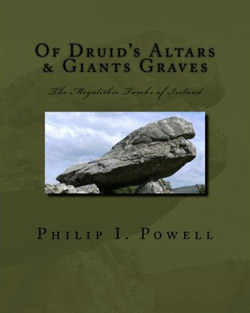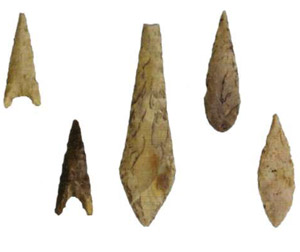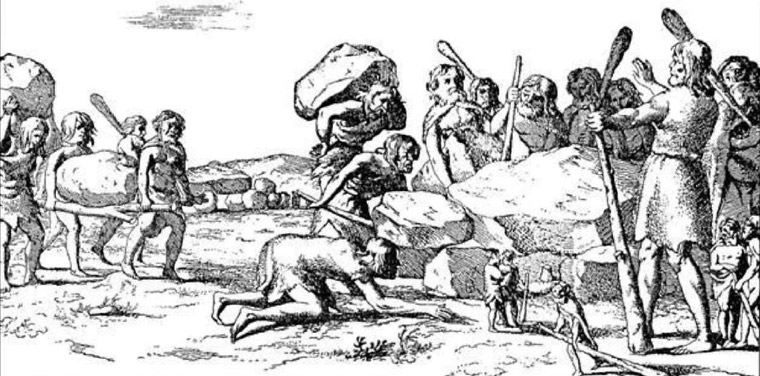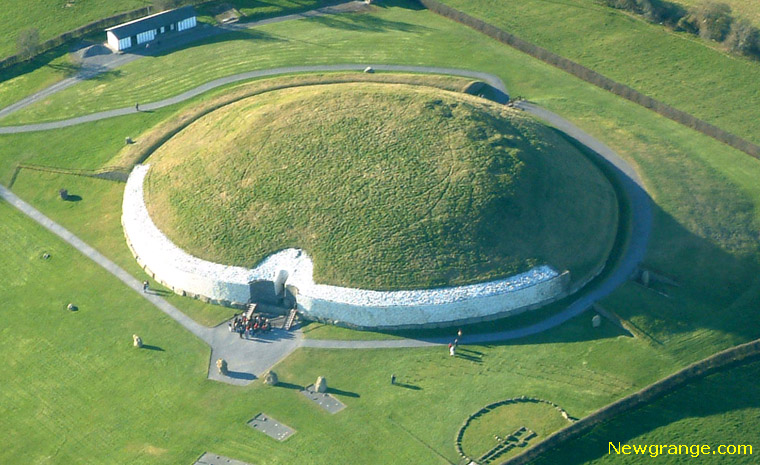Of Druid's Altar's & Giant's Graves
 The Megalithic Tombs of Ireland
by Philip I Powell
The Megalithic Tombs of Ireland
by Philip I Powell
Prehistory in Ireland begins around the 8th-7th millennia BC, a few centuries after the last great Ice Age, when Mesolithic hunter-gatherers arrived on the ancient shores of this island. Our earliest known evidence of human activity in Ireland is from around 8,000 BC, where archaeologists discovered shell middens along the coast of County Antrim.
Shortly before 4,000 BC, farming was introduced into Ireland and this move from the Mesolithic hunter gatherer culture to a Neolithic farming society, was the single greatest social revolution there has ever been. The most prominent remains of this early prehistoric period are the megalithic tombs, the majority of which were constructed in the 4th and 3rd millennia BC (4000-2000 BC). These are the 'Giant's Grave' & 'Druid's Altar' of the Victorian Antiquarians, the 'Leaba Dhiarmada agus Ghrainne' of popular folklore and the 'Cromlech' and 'Dolmen' of earlier writers.
They were not of course 'Druid's Altars' or 'Giants Graves' and nor are they the remains of the nightly beds of the lovers 'Diarmuid & Grainne' but are in fact what remains of sophisticated burial chambers, built by ordinary people, from a highly cultured society, to honour their loved ones and guide them on their way, on their final journey to the next world.
Purchase at Amazon.com or Amazon.co.uk
Introduction - Of Druid's Altar's & Giant's Graves
Prehistory in Ireland, from the archaeological evidence thus far discovered, begins around the 8th-7th millennia BC, a few centuries after the last great Ice Age, when Mesolithic hunter-gatherers arrived on the ancient shores of this island. Our earliest known evidence of human activity in Ireland is from around 8,000 BC, where archaeologists discovered shell middens along the coast of County Antrim. Where these first inhabitants came from is still the subject of much controversy but it is most likely that they came from what is now present day Britain & Western Europe, most likely France and northern Spain. The earliest known Mesolithic site of settlement in Ireland is located in Mount Sandel, Coleraine in County Derry.It is the oldest archaeological site in Ireland where radiocarbon dating has placed occupation at the site to around 7,010 - 6,490 BC. Excavations uncovered the remains of circular huts, middens, food storage pits and areas of flint knapping, with over 44,000 pieces of flint being found, a small portion of which were unused. They lived in family groupings of about 20 individuals, hunting game, fishing and collecting wild berries & nuts and were relatively successful. However, the population never expanded much beyond a few thousand individuals and much, if not all of the landscape that existed before their arrival, was still relatively untouched and unchanged. Their burial rites and rituals are unknown to us, as no burial site has as yet been discovered in Ireland from this period.
Shortly before 4,000 BC, farming was introduced into Ireland and this move from the Mesolithic hunter gatherer culture to a Neolithic farming society was the single greatest social revolution there has ever been. For our ancient ancestors gradually left behind a life style that was not only in tune with nature but was part of nature and moved forward to a time where human beings began to shape the landscape, adapt it for their needs and get it to work for them. The old Mesolithic life style of the hunter-gatherer did not end immediately, in fact it continued on for many more centuries, subsidizing the food produced from the farming but was gradually replaced by the more settled life style of farming and with it the beginnings of communities and ownership of the land began to emerge. Thus, then the 3rd period of the Stone Age had begun, the Neolithic or New Stone Age, and with it the dawn of a new age that would totally transform the world and human society and its consequences are still felt to this day in the way we feed ourselves and the type of communal society we live in.
The most prominent remains of this early prehistoric period are the megalithic tombs, 'Tuama Meigiliteach', the majority of which were constructed in the 4th & 3rd millennia BC (4000-2000 BC). These are the 'Giant's Grave' & 'Druid's Altar' of the Victorian Antiquarians, the 'Leaba Dhiarmada agus Ghráinne' of popular folklore and the 'Cromlech' and 'Dolmen' of earlier writers. From the archaeological evidence and the radiocarbon dating carried out to date, these megalithic tombs first started to be constructed several centuries after the introduction of farming to Ireland. Indeed, these early farmers felt no compelling need to constructed these sometimes enormous megalithic monuments but certain factors such as a rising population and pressure on land resources may well have compelled some agricultural communities to construct communal tombs, particularly if these tombs also served as territorial boundary markers which demonstrated & reinforced their ownership of the land & acted as a public expression of the group identity as well as demonstrating the wealth and status of the community. If this was so then the architectural features of these monuments would most likely depend on a range of factors such as quality of land, local availability of materials & regional modifications. The artefacts discovered so far in and around these tombs give us a small insight into the economy and day to day life of these megalithic builders.
 The flint arrowheads suggest hunting
was still a very important part of everyday Neolithic life and the animal bones tell us
something of the livestock domesticated and hunted by these early farmers. The
polished axes & flint axes, reflect one of the primerary needs of life in Neolithic times
and that is the felling of timber for land clearance to cater for the expanding
agricultural needs of the community and also for house building or perhaps even for
fuel. The impressions of grain in pottery not only tell us something of the type of
grain grown by these early farmers & their diet but these pieces of pottery also tell
us something about their artistic expression in the form of decoration on these
vessels. On rare occasions small pieces of personal jewellery, such as shell-necklaces
or simple beads, are discovered and these important artefacts bring us a little closer
to understanding the actual people who were our ancient ancestors and have only
these monuments and objects to tell their life stories.
The flint arrowheads suggest hunting
was still a very important part of everyday Neolithic life and the animal bones tell us
something of the livestock domesticated and hunted by these early farmers. The
polished axes & flint axes, reflect one of the primerary needs of life in Neolithic times
and that is the felling of timber for land clearance to cater for the expanding
agricultural needs of the community and also for house building or perhaps even for
fuel. The impressions of grain in pottery not only tell us something of the type of
grain grown by these early farmers & their diet but these pieces of pottery also tell
us something about their artistic expression in the form of decoration on these
vessels. On rare occasions small pieces of personal jewellery, such as shell-necklaces
or simple beads, are discovered and these important artefacts bring us a little closer
to understanding the actual people who were our ancient ancestors and have only
these monuments and objects to tell their life stories.
Indeed, it is these very same monuments & artefacts, sometimes found by pure chance, which sowed the seeds of curiosity and intrigue amongst the learned scholars of 19th century Victorian Ireland. This interest in Irish Prehistory had in fact begun much earlier, for in the late 17th century, John Aubrey, published his book 'Monumenta Britannica' (1685) and in it he included a sketch and description of Labbacallee wedge tomb in County Cork. Some of these early antiquarians, however, believed that these tombs were ascribed to the Vikings or Romans or even the Egyptians and that these architecturally, sophisticated structures could in no way have been built by the ignorant & barbarous Irish peasants. Fortunately, at the beginning of the 19th century this attitude began to change with the first systematic, countrywide recording of archaeological sites in Ireland & was carried out after the establishment of the Ordnance Survey in 1824. In 1830 a section was created within the Ordnance Survey called 'Place Names and Antiquities' and it was staffed by three very highly educated scholars, John O'Donovan (1806-1861), Eugene O'Curry (1794-1862), (who later became the first Irish Professor to have 'archaeology' in his title) & George Petrie (1790-1866), who to this day, is regarded as the 'the father of Irish Archaeology'.
It is Petrie's writings on early Irish archaeology and architecture, that were of the greatest significance, especially his essay on the Round Towers of Ireland, which appeared in his book 'The Ecclesiastical Architecture of Ireland' (1845). His meticulous survey & numbering system of the megalithic tombs at Carrowmore, County Sligo in 1837, is still used & referenced in archaeological studies of the site to this day.
Towards the end of the 19th century many attempts were made to classify these monuments. Most notably of these was William Copeland Borlase (1848-1899), an antiquarian, born in Cornwall, who was much influenced in his early life by the archaeological work of his great-great-grandfather, Dr William Borlase. As a young man, Borlase visited many of the ancient sites in Cornwall and supervised the excavations of the re-discovered prehistoric settlement at Carn Euny in 1863. It was the publishing of his mammoth work in 1897, 'The Dolmens of Ireland' in 3 volumes, that Borlase is best remembered for.
It contains almost 900 monuments, giving descriptions, local folklore and structural characteristics, along with hundreds of sketches from Wakeman, Du Noyer & Windele and some from Borlase himself. There was also the later publication by W.F. Wakeman called Handbook of Irish Antiquities (1903), which contained many sketches of field antiquities. Of course none of these aforementioned publications, and many others concerning Irish Archaeology, would have been possible without the extensive work done by the likes of Thomas Johnson Westropp (1860-1922), an Irish antiquarian, who conducted extensive surveys of the field monuments of counties Clare, Limerick & Mayo. He also drew accurate sketches of buildings, the remains of antiquities and grave slabs throughout Ireland. W.G. Wood-Martin recorded many of the megalithic structures in County Sligo and the Rev. James Graves (1815-1886), who devoted his life towards the preservation of the antiquities of his country and in particular that of his native County, Kilkenny.
Although dominated by men, the Victorian, antiquarian society of 19th century Ireland still had its own woman's champion in Miss Margaret Stokes. Miss Stokes (1832-1900), was the daughter of Sir William Stokes, sister of Whitley Stokes and was an Irish Antiquarian noted for her illustrations such as 'The Cromlech at Howth'. Her Early Christian Art in Ireland (1887) was well regarded and she produced two works on early medieval Irish saints in Europe in 1892 & 1895. She was elected an honorary member of the Royal Irish Academy in 1876 & of the Royal Society of Antiquaries of Ireland. We are also forever indebted to the artists of those early days before photography, who used their impressive artistic talents to accurately record for future generations, these magnificent monuments and the artefacts associated with them.
Artists such as William F. Wakeman (1822-1900), a student of Petrie's & an Irish archaeologist, who produced beautiful sketches in pen & pencil of land features and antiquities while he was employed by the Ordnance Survey. Another great artist & antiquarian was George Victor Du Noyer. Du Noyer (1817-1869), was an artist, geologist & antiquarian who combined art and science in recording natural features & archaeological sites around the Irish countryside and his richly embellished small paintings are regarded as veritable works of art. He spent 22 years walking the Irish countryside, surveying all of counties Waterford, Wexford, Cork & Kerry, and much of counties Antrim, Down & Armagh. These early pioneering antiquarians, and many more besides, were at the forefront of what in modern times we now refer to as 'The Science of Archaeology'. Archaeology, (from the Greek archaios, 'ancient', & logos, 'logy'), enables us to reconstruct, from the pottery & tools, much of the story of prehistoric man.
It tells us how they lived and, in death, how they treated their loved ones. It reveals the food they ate and how they procured that food and the art that beautified their lives. It also gives us information about their dwellings and the clothing they wore but this still only represents, a relatively small faction of information, over a period of perhaps four or five thousand years, from which archaeologists can gain some insight into the lives of our ancient ancestors. Most of the megalithic monuments, (from the Greek, megas, 'great', & lithos, 'stone'), are today assigned to four major classes and each are named after an important distinguishing feature.
They are Passage Tombs, Court Tombs, Portal Tombs and Wedge Tombs, with minor categories such as Linkardstown Graves, Cists and Boulder Burial monuments. However, in earlier times, other fantastic notions abounded about the origins and the builders of these great structures. Names such as 'DRUID'S ALTAR' were frequently used to describe portal tombs. It was a name given by pagan-altar theorists, who saw in the covering-stone, the channels cut to carry off the victim's blood. It was this romantic theory, which was enough for the 18th century unscientific antiquarians and historians to condemn it with this name. Another view was that they were altars on which sacrifice was offered around certain times of the pagan calendar.
Another fantastic notion conjured up by these early antiquarians, was their explanation for the size and shape of wedge tombs & court tombs. They believed that they were built by giants to bury their dead and that this would account for their enormous size, and so to them the name 'GIANTS GRAVE' seemed well suited.

Picard's representation of Giants and Dwarfs building the Dolmens
Legends of Giants
Legends of Giants, who undertake extraordinary feats, are very common in Irish mythology. There is the well known myth of the great warrior & giant Fionn mac Cumhaill and his battle with his Scottish rival, Cuhullin. The legend recalls that during this battle, Fionn has built the Giant's Causeway, 'Clochan na bhFomharach', as stepping-stones to Scotland, so as not to get his feet wet. He scoops up part of Ireland to fling it at his rival, but it missed and landed in the Irish Sea; the clump becoming the Isle of Man, a pebble becoming the island of Rockall, 'Rocal', and the void becoming Lough Neagh, 'Loch nEathach', the largest, freshwater lake in the British Isles.Probably the most mystical name given to some tombs is that, that comes from popular Irish folklore. Many wedge tombs around the Irish countryside, and indeed marked on the OS maps as such, are commonly referred to as 'Leaba' or 'Labba', meaning 'bed' in Irish, but a bed in the sense of a grave and it is most likely because of their sepulchral character, that these megalithic tombs were so called. Some tombs are popularly known by various names such as 'Leaba Dhiarmuda agus Grainne' & 'Leaba na bhFiann', in reference to a tale from the Fenian Cycle in Irish Mythology which concerns a love triangle between the great warrior Fionn mac Cumhaill, his bride to be, Grainne, daughter of the High King, Cormac mac Airt, and her lover Diarmuid Ua Duibhne. The eloping lovers were said to have slept each night under a different bed of stones, fleeing to avoid capture and popular folklore assigns these tombs to those beds.
They were not of course 'Druid's Altars' or 'Giants Graves' and nor are they the remains of the nightly beds of the lovers 'Diarmuid & Grainne' but are in fact what remains of sophisticated burial chambers, built by ordinary people, from a highly cultured society, to honour their loved ones and guide them on their way, on their final journey to the next world. For it is these very same special names for our megalithic tombs that help bring our ancient ancestors and their untold day to day life stories closer to us and remind us that they are part of our shared past and of who we are. Despite the archaeological evidence, it is with these names in mind, from the early antiquarians & from popular folklore, that I have named this book so and in recognition of those pioneering archaeologists, I have included, where possible, their own accounts, descriptions and drawings of these extraordinary monuments, a durable testament to their ingenious builders.
Philip I. Powell.
Boyne Valley Private Day Tour
 Immerse yourself in the rich heritage and culture of the Boyne Valley with our full-day private tours.
Visit Newgrange World Heritage site, explore the Hill of Slane, where Saint Patrick famously lit the Paschal fire.
Discover the Hill of Tara, the ancient seat of power for the High Kings of Ireland.
Book Now
Immerse yourself in the rich heritage and culture of the Boyne Valley with our full-day private tours.
Visit Newgrange World Heritage site, explore the Hill of Slane, where Saint Patrick famously lit the Paschal fire.
Discover the Hill of Tara, the ancient seat of power for the High Kings of Ireland.
Book Now
Home
| Visitor Centre
| Tours
| Winter Solstice
| Solstice Lottery
| Images
| Local Area
| News
| Knowth
| Dowth
| Articles
| Art
| Books
| Directions
| Accommodation
| Contact

